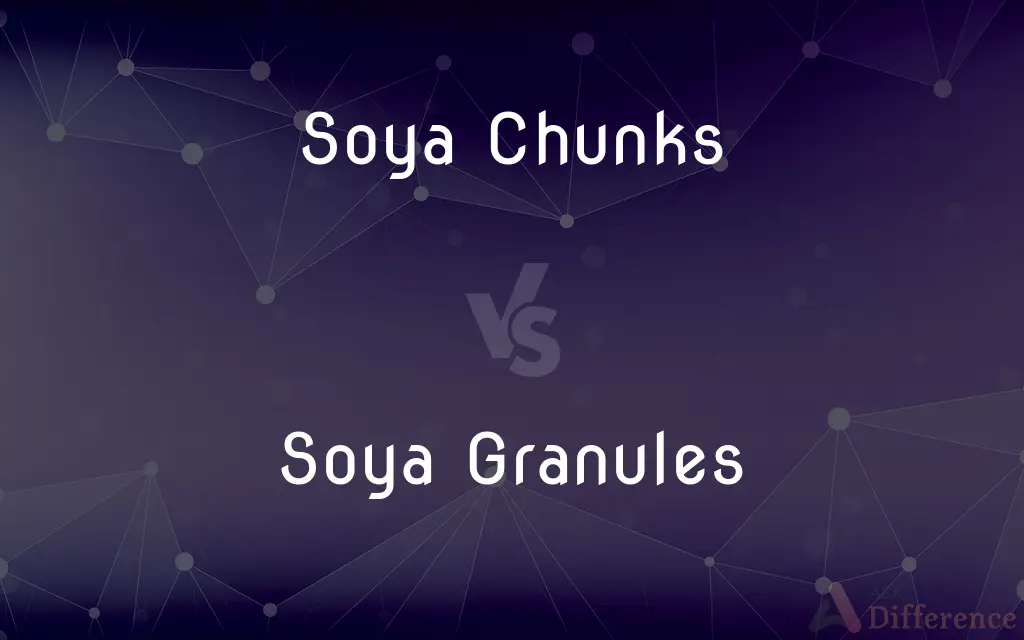Soya Chunks vs. Soya Granules — What's the Difference?
By Tayyaba Rehman & Urooj Arif — Published on February 4, 2024
Soya chunks are large, meaty textured soy products, ideal for replacing meat in dishes, while soya granules are smaller, ground-up versions, great for binding mixtures like burgers or as fillers.

Difference Between Soya Chunks and Soya Granules
Table of Contents
ADVERTISEMENT
Key Differences
Soya chunks, often referred to as textured vegetable protein (TVP) chunks, are made from defatted soy flour. They have a meat-like texture when cooked, making them a popular meat substitute. Soya granules, also derived from defatted soy flour, are smaller and resemble coarse grains. They are used as meat extenders or to add texture to vegetarian dishes.
Soya chunks are known for their ability to absorb flavors and sauces, making them suitable for stews and curries. Their chunky nature provides a satisfying bite. Soya granules, with their finer texture, are perfect for recipes where a smoother consistency is desired, like in spaghetti bolognese or as a stuffing base.
In terms of preparation, soya chunks require soaking or boiling to become tender before adding to recipes. This process is essential to achieve the right texture. Soya granules, being smaller, hydrate more quickly and can often be used directly in cooking without a lengthy pre-soak.
Nutritionally, both soya chunks and granules are high in protein and low in fat, making them healthy meat alternatives. Soya chunks, due to their larger size, may provide a more satisfying mouthfeel akin to meat, while granules are more versatile for blending into a variety of dishes seamlessly.
Lastly, in terms of storage and shelf life, both soya chunks and granules have a long shelf life when stored in a cool, dry place. They are both susceptible to moisture, so proper storage is key to maintaining their quality.
ADVERTISEMENT
Comparison Chart
Texture
Larger, chunkier, and meat-like texture
Smaller, granular, and smoother texture
Cooking Method
Requires soaking or boiling
Hydrates quickly, minimal prep needed
Best Used For
Stews, curries, meat substitutes
Fillers, binding, mince-like dishes
Nutritional Content
High in protein, low in fat
High in protein, low in fat
Storage
Long shelf life, needs dry storage
Long shelf life, requires dry storage
Compare with Definitions
Soya Chunks
Ideal for absorbing flavors, making them versatile in various cuisines.
I marinated soya chunks overnight for my barbecue.
Soya Granules
Store well, convenient for long-term use in cooking.
I keep soya granules in my pantry for quick meal fixes.
Soya Chunks
Offer a meat-like texture suitable for vegans and vegetarians.
Soya chunks are my go-to for making vegan stir-fry.
Soya Granules
Quick to prepare, easily absorbing flavors and sauces.
Soya granules seamlessly blend into my pasta sauce.
Soya Chunks
Large, textured pieces made from soy protein, often used as meat substitutes.
I replaced chicken with soya chunks in my curry.
Soya Granules
Small, ground soy products used as meat extenders or fillers.
I added soya granules to my meatballs for extra volume.
Soya Chunks
A healthy alternative, rich in protein and low in fat.
I use soya chunks in my diet for a protein-rich meal.
Soya Granules
Provide a smooth texture, ideal for mince-like dishes.
I use soya granules for my vegetarian tacos.
Soya Chunks
Require hydration before cooking, expanding to several times their size.
Soak the soya chunks in hot water before adding them to your stew.
Soya Granules
Nutritious and protein-rich, suitable for various diet plans.
Soya granules add a protein boost to my salads.
Common Curiosities
Are Soya Chunks healthy?
Yes, soya chunks are a good source of protein, fiber, and essential nutrients like iron and calcium. They are often used as a meat alternative in vegetarian and vegan diets.
How do you cook Soya Chunks?
Soya chunks need to be soaked in hot water or boiled briefly before use. After soaking, they can be added to various dishes like curries, stir-fries, and soups.
Do Soya Chunks have a strong flavor?
Soya chunks have a neutral taste, which makes them versatile and suitable for absorbing the flavors of the dishes they are cooked in.
How are Soya Chunks made?
Soya chunks are produced by extracting the oil from soybeans and then processing the remaining soy protein into small, granular or chunky shapes.
What are soya chunks?
Soya chunks are textured soy protein pieces, used as meat substitutes.
Are Soya Chunks gluten-free?
Yes, soya chunks are naturally gluten-free, making them suitable for those with gluten sensitivities or celiac disease.
How should Soya Chunks be stored?
Soya chunks should be stored in an airtight container in a cool, dry place to maintain their freshness.
Can Soya Chunks be used in salads?
Yes, you can use soaked and boiled soya chunks in salads to add a protein boost and texture.
What are Soya Granules?
Soya granules, also known as soy granules or soy granules, are small, granular-textured soy-based products made from defatted soy flour.
How are Soya Granules made?
Soya granules are produced by processing soy protein into small granules after the oil is extracted from soybeans.
Are Soya Granules similar to Soya Chunks?
Yes, both soya granules and soya chunks are soy-based products, but they differ in texture and size. Soya granules are smaller and finer than soya chunks.
Are Soya Granules suitable for vegetarians and vegans?
Yes, soya granules are a plant-based protein source, making them suitable for both vegetarians and vegans.
Are Soya Chunks the same as Tofu?
No, soya chunks are not the same as tofu. Tofu is made from soybean curd and has a different texture compared to soya chunks.
How do you cook Soya Granules?
Soya granules need to be soaked in hot water or boiled briefly before use. They are commonly used in dishes like keema, stuffing, and gravies.
Are Soya Chunks a complete protein source?
Yes, soya chunks are considered a complete protein source as they contain all essential amino acids needed by the body.
Share Your Discovery

Previous Comparison
Endowment Insurance vs. Whole Life Insurance
Next Comparison
Brazilian Blowout vs. Keratin TreatmentAuthor Spotlight
Written by
Tayyaba RehmanTayyaba Rehman is a distinguished writer, currently serving as a primary contributor to askdifference.com. As a researcher in semantics and etymology, Tayyaba's passion for the complexity of languages and their distinctions has found a perfect home on the platform. Tayyaba delves into the intricacies of language, distinguishing between commonly confused words and phrases, thereby providing clarity for readers worldwide.
Co-written by
Urooj ArifUrooj is a skilled content writer at Ask Difference, known for her exceptional ability to simplify complex topics into engaging and informative content. With a passion for research and a flair for clear, concise writing, she consistently delivers articles that resonate with our diverse audience.
















































